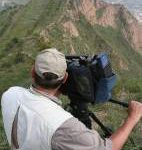The mountain ranges of the Tibetan plateau contain the largest concentration of glacier ice outside of the high latitudes, yet, until quite recently, large areas were relatively unknown to western scientists. In the last couple of years, a number of scientific reports written by Chinese glaciologists have provided inventories of the mountain glaciers of Tibet and assessed their response to recent climate change. These findings make uncomfortable reading.
The Tibetan plateau is bounded by enormous mountain ranges — to the south by the Himalayas, to the north by the Tian Shan and to the west by the Karakoram and Pamirs — and is the size of western Europe, forming the largest high-altitude land mass on earth. At an average height of around 4,000 meters above sea level, the plateau contains more than 45,000 individual glaciers covering about 90,000 square kilometers and extensive permafrost.
Recent work by Dong Guangrong at the Chinese Academy of Sciences has shown that recent climate change has had a severe impact on the mountain glaciers and permafrost of Tibet and threatens to affect water supplies to many of the rivers draining the plateau. His analysis of data from 680 Chinese weather stations shows that average temperatures in Tibet have risen 0.9° centigrade since the 1980s and this has precipitated an annual 7% reduction in glacier extent and the melting of permafrost. These findings provide further support to research published in 2005 by American scientists who observed significant recent warming in Tibet from ground-based surveys.
These observations are in line with those from other regions of the earth and there is now a general consensus among climate scientists that the planet is undergoing significant warming, mainly as a result of human-induced emissions of greenhouse gases and land-use changes. The last Intergovernmental Panel on Climate Change Third Assessment Report (IPCC TAR) was published in 2001, and showed that global mean surface temperatures had risen some 0.6 centrigrade since the beginning of the 20th century. While to many this temperature rise does not seem significant, palaeoclimatological studies suggest that this means that the earth is warmer than it has been for at least the last 1,000 years (NAS 2006) and there is compelling evidence from glaciers to suggest that the planet is warmer now than it has been for 5,000 years. In addition, warming is occurring at a faster rate than for the last 10,000 years. The consequences of this temperature rise have been well documented, but include rapid recession of mountain glaciers, rising sea levels, changing patterns and intensities of rainfall and drought events and latitudinal shifts in ecological systems. Projections of future temperature rise during this century using computer models range from around 2 to 6 degrees centigrade; projections from assessment of past climate sensitivity suggest that warming could be even higher. The implications of such change for ecological, economic and political systems would be enormous.
There are also clear societal implications of climate change. Globally, around 1.7 billion people live in arid regions with restricted drinking water and this number is expected to rise to 5 billion within the next 25 years. Similar findings from similar studies from other parts of the world reinforce the message that climate change is global in extent and that warming is not an artefact of urban heat islands. Two things make the Chinese study unusual, however. First, glacier recession and permafrost degradation in Tibet is inextricably linked to changes in water supply and dust storms, and, second the extent of the changes to the Tibetan environment may have global climatic significance.
Glacier recession and water supply
Water supply increases during the period of glacier recession and the period of time when flow is high is extended as the ablation (melting) season extends. This period may be short-lived, as once the glacier has melted (or has become covered with debris), runoff is greatly reduced and will eventually depend upon more seasonal precipitation, changing the variability of river discharge, with consequent impacts upon agricultural systems downstream.
Glacier recession has other implications for water supply. As glaciers melt and lose mass, surrounding hillsides become unstable, producing debris flows and rock slides which deliver large amounts of sediments into the valley bottoms. This increases the sediment load of rivers, which adversely affects hydro-electric power schemes downstream and reduces the economic life of reservoirs and irrigation schemes.
In China, recession of the mountain glaciers threatens to disrupt the water supply of over 300 million people as many of the great rivers of the Asian continent (Yellow, Mekong, Indus, Ganges and others) have their headwaters on the Tibetan plateau, and in over 100 cities in China, including Beijing, the water situation is critical. As is the case with other arid Asian countries, climate change, water supply, and social and economic stability are inextricably linked.
Dust storms
Deserts in China are related largely to the position and nature of the east-Asian and Indian summer monsoons, which control rainfall. They are located in the arid centre of the country, away from oceanic influences and protected by the mountains to the west and south from incursion of rain-bearing winds. During the winter, they are affected by the Siberian high-pressure system bringing dry and very cold conditions. Climate change, allied to unsustainable land-use practices, is increasing the number and size of dust storms from these deserts. A report in 2001 showed that 2,300 square kilometers of topsoil is lost to dust storms each year from northern China alone. This year, northern China experienced 13 major dust storms, one of which deposited over 330,000 tons of sand in Beijing in April and others have deposited dust in Russia, South Korea and the central United States.
Permafrost melting
Dust storms are also associated with thawing of previously frozen soils and, with much of the Tibetan plateau underlain by permafrost, climate change threatens to increase the scale of desertification in the region. Of wider concern is the likely positive feedback to global warming caused by the release of greenhouse gases such as methane and carbon dioxide from frozen soils as they thaw.
Recent studies have shown that methane will be released if melting permafrost produces waterlogged soils, and carbon dioxide if the soils dry out. With estimates of the amount of carbon locked up in permafrost ranging between 60 and 190 billion tons, thawing of the soil over vast tracts of the Tibetan plateau will produce an enormous release of greenhouse gases to the atmosphere and a likely further step-change in global warming, with severe consequences for us all.
Studies such as these demonstrate how interconnected the climate system is; emissions of greenhouse gases in one part of the world impact upon glaciers and permafrost in another, which in turn result in further emissions. The melting of glaciers in China is not only of concern to the Chinese.
The Author: Stephan Harrison is a geomorphologist, specialising in landscape responses to climate change, at Exeter University and Oxford University. He has worked in the mountains of central Asia, Patagonia, central Europe and northern Scandinavia on climate change issues.

